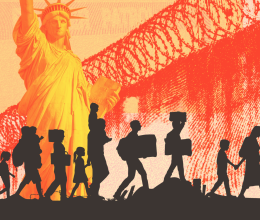
It started out as an ordinary hot summer day in the borderlands. On June 18, 2019 Anastacio Granillo, a 64-year-old New Mexican man, spent the afternoon with his wife’s cousin visiting family in Mexico. But as the two headed back into New Mexico, the day took a turn for the worse.
As they pulled up to the Columbus Port of Entry, they were met by a long line. When they finally reached the front and were asked their citizenship status, Granillo suggested to Officer Orrantia, the Customs and Border Protection (CBP) officer on duty, that it would be helpful to open up another lane to allow for faster processing of vehicles in the sweltering heat. The officer scolded Granillo, saying CBP officers could do whatever they wanted.
Orrantia then asked Granillo what he was bringing into the United States. He attempted to hand the allergy medication he purchased across the border to Orrantia but, nervous due to the officer’s aggressive behavior, accidentally dropped it into his hands. Orrantia then accused Granillo of throwing the medication at him. Granillo assured him that he dropped the medication unintentionally, but Orrantia, who was armed with a gun, opened the driver’s-side door of the vehicle where Granillo was seated without any verbal warning.
"There’s a fear it’s going to happen again."
Orrantia ordered Granillo out of the vehicle. When Granillo asked why he had to exit his car, Orrantia threw his body weight on top of him, pinning him against the seat. Orrantia then forced Granillo out of the vehicle and slammed him against a wall in the inspection bay, causing him to hit his head, and fall to the ground.
While Granillo lay on the ground disoriented, Orrantia held his right arm behind his back, kicked him, and cuffed him.
“They are federal officers so there’s a feeling that you can’t do anything and that they are protected, and they can do anything they want without any consequences,” said Granillo. “That’s what they did to me.”
Several CBP officers soon took Granillo, who had bruises on his right arm and left leg and a large bump on his head, into the CBP office at the port of entry. About twenty minutes went by before they even offered to call an ambulance for Granillo. When EMTs finally arrived, one of them told Granillo it wasn’t their first encounter with Orrantia — that he had a history of brutalizing people crossing the border.
After observing and documenting his injuries, EMTs offered to give Granillo a ride in the ambulance to the hospital. Though he wanted to go, Granillo declined after CBP officers told him that he would have to foot the bill, even though one of their officers was responsible for his injuries.
The largest and least accountable law enforcement agency
Granillo’s experience is just one of thousands of stories of unnecessary abuses by CBP, the largest federal law enforcement agency in the country.
The Southern Border Communities Coalition has tracked deaths at the hands of CBP based on media coverage and press releases, and has found that since January 2010, at least 150 people have died as a result of an encounter with CBP. The causes of death range from excessive force (including fatal shootings, asphyxiation, tasers, beatings, and spraying of chemical agents), failure to provide adequate medical care, and vehicle collisions, to homicides carried out by off-duty officers or agents.
In addition to the 150 deaths that we know of, CBP officers and agents have brutalized and mistreated countless others.
In 2016, the ACLU of New Mexico won a $1.1 million settlement on behalf of a New Mexico woman who, while returning home from Mexico through the Bridge of the Americas Port of Entry in El Paso, was accused of smuggling drugs and illegally subjected to vaginal and anal searches.
"It’s so unpredictable how you’re going to be treated and you never know if you’re going to get someone who will mistreat you. I’m afraid what happened before will happen again."
After examining Jane Doe’s (whose name has been changed to protect her identity) genitals and anus with a flashlight at the port of entry, and failing to find any contraband, CBP officers nevertheless transported her to University Medical Center for further examination. Over the course of six brutal hours, she suffered an observed bowel movement, an X-ray, a speculum exam of her vagina, a bimanual vaginal and rectal exam, and a CT scan. The officers did not have a warrant, and Jane Doe never consented to an examination.
The ACLU of New Mexico has demanded authorities investigate additional instances of abuse at ports of entry in Texas and New Mexico that include CBP personnel forcefully yanking a defenseless boy out of a vehicle; calling a noncitizen a “wetback” and denying access to her diabetes medication; coercing individuals to accept swift deportations with long-term consequences that bypass the judicial process; and detaining a grandmother for ten hours who was crossing into the United States for her weekly Walmart trip, after accusing her of being a sex worker.
CBP abuse doesn’t end at ports of entry. Agents harass, assault, and even kill people throughout border communities with alarming frequency.
This past summer, on August 3, CBP agents chased a vehicle along New Mexico Highway 185 in the El Paso Border Patrol sector, killing two people and causing eight others to be hospitalized. On September 18, agents pursued a vehicle near Deming, which resulted in a crash that killed one person and injured nine others. Since 2010, the ACLU has tracked 56 deaths resulting from Border Patrol-involved chases.
Despite a well-documented history of abuse, as well as calls for transparency and accountability from immigrant rights organizations, family members of loved ones, and elected officials, CBP agents and officers continue to act with impunity. In its 90-year history, no CBP officer or agent has ever been convicted of criminal wrongdoing while on duty.
To truly stop the largest and least accountable law enforcement agency in the nation from systematically abusing people, the United States Congress must cut funding to the agency. The ACLU will keep fighting to bring abuse to light and to pressure Congress to divest from the agency and reinvest in communities. And we will continue to seek justice for its victims in the courts.
Fighting back
It’s been over two years since Granillo’s assault. But each time Anastacio returns from Mexico after visiting his family or picking up medication, he feels a familiar dread bubbling up in his stomach.
“I get my medicines in Mexico, so I cross this port of entry regularly,” Anastacio said. “There’s a fear it’s going to happen again. It’s so unpredictable how you’re going to be treated and you never know if you’re going to get someone who will mistreat you. I’m afraid what happened before will happen again.”
"If I let it go and no one does anything, they’ll continue to treat people this way."
Granillo also suffers from short term memory loss, weakness in his hands and legs, mood swings, and anxiety — none of which he experienced before his assault.
“Mr. Granillo was simply trying to make his way home to Deming when he was assaulted by a CBP officer for no reason,” said María Martínez Sánchez, deputy legal director at the ACLU of New Mexico. “Now, he’s suffering the consequences of that violent encounter. Officers like the one that assaulted Mr. Granillo pose a danger to everyone they come in contact with and must be held accountable for their actions, or they will continue to abuse their power.”
Despite his fear, Granillo isn’t giving up. In August 2021, the ACLU of New Mexico filed a civil suit on his behalf seeking justice for the assault, battery, negligence, and false arrest he endured.
He hopes that his suit will help prevent other people like him from facing similar abuse.
“They regularly abuse people at the border,” Granillo said. “I’ve seen this happen to too many people and I’ve had enough. If I let it go and no one does anything, they’ll continue to treat people this way.”



